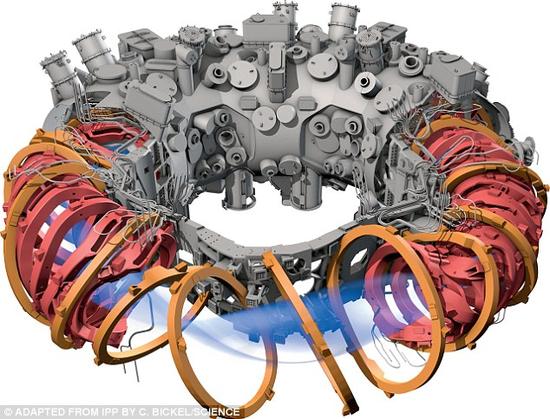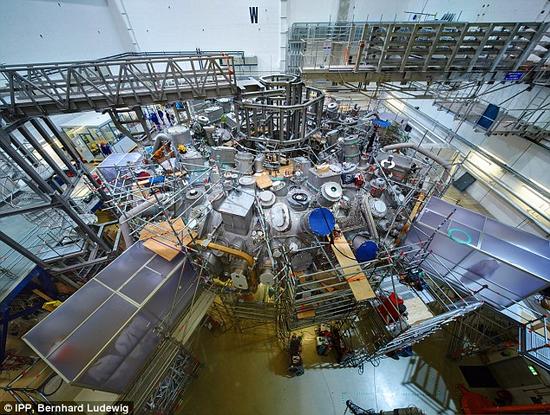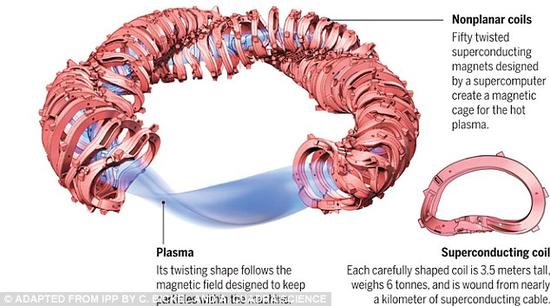According to news on October 30, Beijing time, scientists are close to putting the world's largest "stereaster" into use. The so-called "Stellarator" (Stellarator), as its name implies, is an imitation of a star, which is essentially a nuclear fusion reaction research device. The "Wendelstein 7-X (W7-X)" code, mentioned here, can continuously confine ultra-high temperature plasma for up to 30 minutes in a single run. The device is located in Greifswald, Germany, and the researchers said that this extraordinary design will eventually help humans convert controlled nuclear fusion into reality.

Scientists are close to putting the world's largest "stellacrolator" into use. This stellarator is codenamed "Wendelstein 7-X (W7-X)". It can continuously confine ultra-high temperature plasma for up to 30 minutes in one run.

The device is located in Greifswald, Germany. The researchers said that this extraordinary device will ultimately help humans to control nuclear fusion into reality.
For a long time, achieving long-term restraints on ultra-high temperature plasma has been a holy grail for reactor design because it will be able to provide humans with almost inexhaustible energy. Nuclear fusion reactors, like the W7-X reactors mentioned here, use two types of hydrogen atoms to operate—the crucible and the crucible—and inject these gases into the containment chamber. The scientists then applied energy to these electrons, so that the electrons of these hydrogen isotopes get out of the atom and form a plasma, releasing enormous energy in the process. A strong magnetic field will prevent these plasmas from approaching the bulkheads. This powerful magnetic field is generated by superconducting coils that wrap around the restraint capsules and currents that exist in these plasmas.
The most common design scheme in the nuclear fusion field is known as "Tockmark," and its typical appearance is a hollow metal compartment that looks a bit like a doughnut. Subsequently, the "fuel" began to be heated until the temperature exceeded 15 million degrees Celsius, resulting in an ultra-high temperature plasma.

This is the result of preliminary testing of the system. The development of this device uses superconducting material technology to achieve high-efficiency magnetic confinement.

In the stellarator, the external coil generates a powerful buckling magnetic field that confines the internal plasma
However, although Tokamak devices are well-suited for confining these plasmas, there are still some safety hazards, such as current interruptions or magnetic field interruptions that will have serious consequences. Such interruptions will cause damage to the entire reactor.
Scientists at the Max Planck Institute in Germany pointed out that the W7-X reactor is a more practical choice, which can overcome the safety problems that exist in the design of Tokemak devices.
David Anderson, a nuclear engineer at the University of Wisconsin-Madison, said: “People working in the Tokamak field are watching the progress closely and are flooding the world with W7-X. The excitement of the device."
In the Tockmark design, two sets of powerful magnets are used to provide plasma confinement. One set is placed around the vacuum chamber and the other set is inside to actuate plasma motion within the vacuum chamber. However, such a design will cause the internal magnetic field of the device to be stronger than the outside, so that the plasma inside the Tokemak device may rush toward the outer wall of the device and combine there with the electrons to become atoms again.
In the “stuttering deviceâ€, the plasma uses a twisted magnetic induction line generated by an external magnetic coil to confine the internal operating plasma, and thus there is no such problem.
The core component of the "stupler" design is a magnetic coil device with a height of about 3.5 meters, and the entire device has a width of about 16 meters.
The stellarator design was first proposed in 1951 by Lyman Spitzer, a renowned physicist working at Princeton University. However, at the time, it was widely believed that the design was too complicated and it was difficult to overcome these difficulties by using material technologies in the middle of the 20th century. Now, with the advancement of superconducting materials and other new material technologies, researchers believe that they will finally be able to turn Spitzer’s genius ideas into reality.
Professor Johanna Wanka of the German Federal Ministry of Education and Research said: "We all know the global development trend and the thirst for energy in some emerging countries. So when we talk about energy, we need to study Working to ensure that we are open to all options and one of the options is nuclear fusion technology. Wendelstein 7-X is a key step towards better assessment of nuclear fusion technology."
The entire facility took over 1.1 million work hours for engineers to assemble. In the process, they used the world’s most sophisticated engineering model to date.
By June of this year, the engineers finally completed magnetic field tests on the "Wendelstein 7-X" equipment, which was much earlier than expected. The relevant test results show that the magnetic field used for plasma confinement is in the condition of millions of degrees Celsius, and its mode of operation is fully consistent with the scientists' previous expectations. At present, the device is waiting for approval from related parties so that it can be officially put into operation in November this year. If it can prove that the device is working properly then scientists believe it will change the direction of research in the nuclear reactor research field.
Exit Sign Acrylic Panel,Acrylic Sign Board With Led,Acrylic Sheet Sign Board,Signage Acrylic Board
NINGBO JIMING ELECTRIC APPLIANCE CO., LTD. , https://www.feituosafety.com
